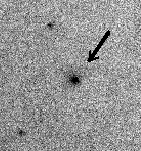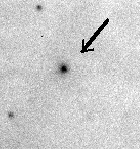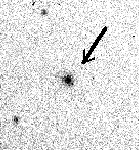









Circular No. 7075
Central Bureau for Astronomical Telegrams INTERNATIONAL ASTRONOMICAL UNION Mailstop 18, Smithsonian Astrophysical Observatory, Cambridge, MA 02138, U.S.A. IAUSUBS@CFA.HARVARD.EDU or FAX 617-495-7231 (subscriptions) BMARSDEN@CFA.HARVARD.EDU or DGREEN@CFA.HARVARD.EDU (science) URL http://cfa-www.harvard.edu/iau/cbat.html Phone 617-495-7244/7440/7444 (for emergency use only)
COMET C/1998 Y2 (LI)
Weidong Li, Department of Astronomy, University of California at Berkeley, reports his discovery of a comet in the course of the Lick Observatory Supernova Search (cf. IAUC 6627; with the participation of M. Papenkova, E. Halderson, M. Modjaz, T. Shefler, J. Y. King, R. R. Treffers and A. V. Filippenko). The object was found automatically by the Katzman Automatic Imaging Telescope in the field of NGC 1041, but it was immediately recognized as a comet by Li, who then used the equipment to make a deliberate confirmatory observation, as well as follow-up observations on the following night. Available CCD astrometry:
1998 UT
R.A. (2000) Decl.
m1 Observer
Dec. 26.23575 2 40 26.37
- 5 25 56.4 16.2
Li
26.26623
2 40 26.47 - 5 25 27.3
16.1
"
27.31124
2 40 32.08 - 5 08 39.7
15.3
"
27.31584
2 40 32.12 - 5 08 34.1
15.3
"
27.32030
2 40 32.08 - 5 08 29.5
15.5
"
28.00613
2 40 37.04 - 4 57 25.8
15.0 Kowalski
28.02951
2 40 37.28 - 4 57 02.8
"
28.04815
2 40 37.20 - 4 56 43.1
"
28.13387
2 40 37.85 - 4 55 23.0
15.5 Bell
28.14006
2 40 37.87 - 4 55 17.3
"
28.16014
2 40 37.99 - 4 54 57.8
"
Parabolic orbital elements follow. The comet is likely of short period.
T = 1999 Feb. 1.854 TT Peri. = 335.683 Node = 87.914 2000.0 q = 2.67161 AU Incl. = 26.412
1998/99 R.
A. (2000) Decl. Delta
r Elong.
Phase m1
Dec. 28
2 40.61 - 4
57.5 2.091 2.698 118.1
18.7 14.9
Jan. 2
2 41.51 - 3
35.7 2.134 2.691 114.2
19.5 14.9
7 2 42.98
- 2 12.5 2.180 2.685 110.4
20.1 15.0
12
2 45.01 - 0
48.4 2.229 2.681 106.5
20.6 15.0
17
2 47.60 + 0
36.1 2.281 2.677 102.8
21.0 15.1
22
2 50.72 + 2
00.5 2.336 2.674
99.1 21.3
15.1
Additional observations from various telescopes in the world suggest that
the period of the comet is about 15.2 years.
Return to KAIT
home page